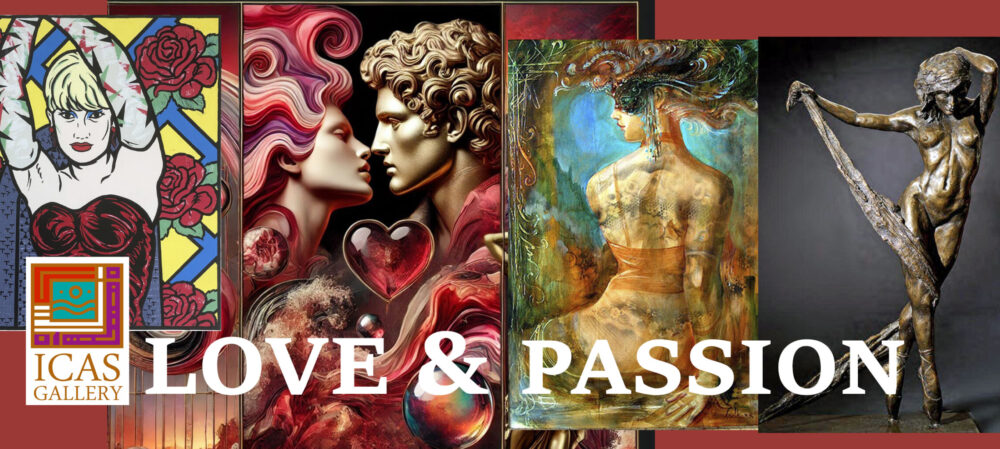Classical Renaissance Figurative Painter
“I strongly believe that the greatest creation in the universe is the human form especially the female form.”
Norik Dilanchyan is an ICAS gallery artist currently presenting his work in our mixed group exhibition, “Venetian Celebration.” Dilanchyan’s collection includes original oil paintings, with three pieces selected for studio limited edition prints. As a classical Renaissance Figurative painter, Dilanchyan views the human figure, particularly the female form, as a central theme in his work.
 He regards it as the most remarkable creation in the universe. Dilanchyan began his artistic journey at a very young age, starting art lessons at six and later graduating from the State University of Arts in Yerevan from 1976 to 1980 with a degree in Fine Art. He joined the prestigious Young Artists Association of the Republic of Armenia during this time. His early works focused on mythical themes inspired by old masters like Caravaggio, Rubens, and Rembrandt, using techniques of pencil and charcoal drawings.
He regards it as the most remarkable creation in the universe. Dilanchyan began his artistic journey at a very young age, starting art lessons at six and later graduating from the State University of Arts in Yerevan from 1976 to 1980 with a degree in Fine Art. He joined the prestigious Young Artists Association of the Republic of Armenia during this time. His early works focused on mythical themes inspired by old masters like Caravaggio, Rubens, and Rembrandt, using techniques of pencil and charcoal drawings. Later in his career, Dilanchyan was influenced by the impressionist movement of the 19th century. His art shifted towards capturing the essence of his subjects through short, thick strokes of paint and vibrant impasto colours. His technique emphasizes the interplay of light and colour, focusing on reflection and optical mixing.
His recent works focus on the female form amidst symbolic backgrounds, evoking drama, music, and melody themes. In 1992, Dilanchyan moved to the United States, which proved to be a turning point in his career, providing him with new opportunities to refine his techniques and explore colour concepts in still life and landscapes.
His art gained recognition through exhibitions at Mark Alan Galleries in Laguna Beach and Newport Beach from 1994 to 1996 and numerous group shows across Fresno, Whittier, LA, and San Francisco. Dilanchyan’s artworks have garnered international recognition and are cherished by private and corporate collectors worldwide.
His art spans Armenia, Estonia, Europe, the U.S.A., and the U.K. His unique perspective on Venetian Art is a vibrant cultural tapestry that you can immerse yourself in. We invite you to explore Norik’s paintings and witness his artistic journey that spans decades of hard work and dedication.
NORIK DILANCHYAN Venetian art collection
THE STORY OF THE VENETIAN CARNIVAL MASK
Every year, the Carnival in Venice, Italy, is held from February to March. It dates back to 1168 as a celebration of the victory of the Republic of Venice against Ulrico,
When we think about Venetian masks, the images that come to mind are of the Venice Carnival, with all their feathers, fancy hats and extravagant patterns. In effect, the world of Venetian masks is far more complex. Ancient Venetians did not put on their masks solely during the Carnival period but instead during most of the year, at least as long as the Venetian Serenissima Republic lasted until 1797.
The tradition of mask-wearing is quite old, and the first written source bearing witness to such usage dates back to May 2, 1268. Masks in Venice were, therefore, a symbol of freedom, a way to eliminate social rules and conceal the masked person’s identity and social status during Carnival and everyday life.
We witness the wearing of masks captured in the early paintings of Pietro Longhi (November 5 1702 – May 8, 1785), a painter of the Rococo period known for his small scenes of Venetian social and domestic life.
 For all private or corporate commissions by our gallery artists, please contact Sunil Vilas,
For all private or corporate commissions by our gallery artists, please contact Sunil Vilas,ICAS Vilas Art Gallery
21 Commerce Way
Garden Square Shopping Centre, Letchworth Garden City SG6 3DNPhone: 01462677455
Email: info@vilasart.co.uk
ICAS Vilas Art Gallery
21 Commerce Way
Garden Square Shopping Centre,
Letchworth Garden City SG6 3DNGarden Square Shopping Centre,
Email: info@vilasart.co.uk
ART NEWS VIDEOS & PUBLICATION






